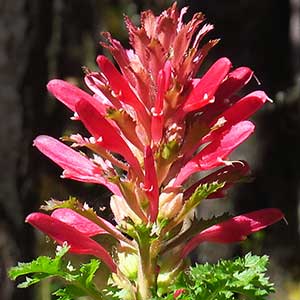Pedicularis densiflora
Pedicularis centranthera
Indian warrior, warrior's plume
dwarf lousewort, Great Basin lousewort
basal 1–10, blade lanceolate, 30–200 x 20–70 mm, 2(or 3)-pinnatifid, margins of adjacent lobes nonoverlapping or extensively overlapping distally, 1-serrate, surfaces glabrous, hispid, or downy;
cauline 4–20, blade lanceolate, 15–250 x 5–100 mm, 2-pinnatifid, margins of adjacent lobes nonoverlapping or extensively overlapping distally, serrate, surfaces glabrous, hispid, or downy.
basal 6–8, blade elliptic or spatulate, 35–120 x 10–30 mm, undivided or 1- or 2-pinnatifid, margins of adjacent lobes nonoverlapping or extensively overlapping distally, entire or 1- or 2-serrate, surfaces glabrous or scattered abaxial glands;
cauline 0–4, blade elliptic, sometimes lanceolate, 20–110 x 5–30 mm, 1- or 2-pinnatifid, margins of adjacent lobes overlapping distally, 1- or 2-serrate, surfaces glabrous.
simple, 1–5, exceeding basal leaves, each 10–50-flowered;
bracts lanceolate to trullate, 10–35 x 3–5 mm, undivided or 1-pinnatifid, proximal margins entire, distal 1- or 2-serrate, surfaces glabrous.
simple, 1–4, not exceeding basal leaves, each 8–14-flowered;
bracts spatulate, 40–60 x 3–6 mm, undivided proximally, undivided or 1-pinnatifid distally, proximal margins entire, distal 1- or 2-serrate, surfaces glabrous, sometimes arachnoid along main veins.
2–4 mm.
1–5 mm.
calyx 9–18 mm, downy to tomentose, lobes 5, triangular, 3–4 mm, apex entire, ciliate;
corolla 23–43 mm, tube dark red, purple, or orange-yellow, rarely white, 8–18 mm;
galea dark red, purple, or orange-yellow, rarely white, 15–25 mm, beakless, margins entire medially and distally, apex straight;
abaxial lip dark red, purple, or orange-yellow, rarely white, 8–15 mm.
calyx 17–22 mm, glabrous, lobes 5, narrowly triangular, 4–7 mm, apex entire or serrate, glabrous or ciliate;
corolla 28–40 mm, tube white or pale purple, 15–30 mm;
galea white or pale purple, apically sometimes dark violet to purple, 13–15 mm, beakless, margins entire medially and distally, apex arching over abaxial lip;
abaxial lip purple, 1–4 mm.
= 16.
Pedicularis densiflora
Pedicularis centranthera
Scarlet corollas with an undomed, toothless galea and two- or three-pinnatifid leaves are diagnostic of Pedicularis densiflora. This species occurs in forested subalpine regions of southern Oregon, western slopes of the Sierra Nevada, and the Coast Ranges of California south to Baja California. Herbarium records indicate northern populations of P. densiflora occur at higher elevations than do more southern populations.
(Discussion copyrighted by Flora of North America; reprinted with permission.)
Varieties 2 (2 in the flora).
The leaves of Pedicularis centranthera exceed the inflorescence, giving the impression that the cauline leaves are basal. Proximalmost basal leaves are distinct: brown, membranous, and spatulate with undivided and entire margins. Pedicularis semibarbata has similar basal leaves.
Pedicularis centranthera occurs in evergreen forests, often under pinyon pine, juniper, ponderosa pine, and yellow pine.
(Discussion copyrighted by Flora of North America; reprinted with permission.)
1. Bracts arachnoid and/or margins ciliate. | var. centranthera |
1. Bracts glabrous. | var. exulans |


